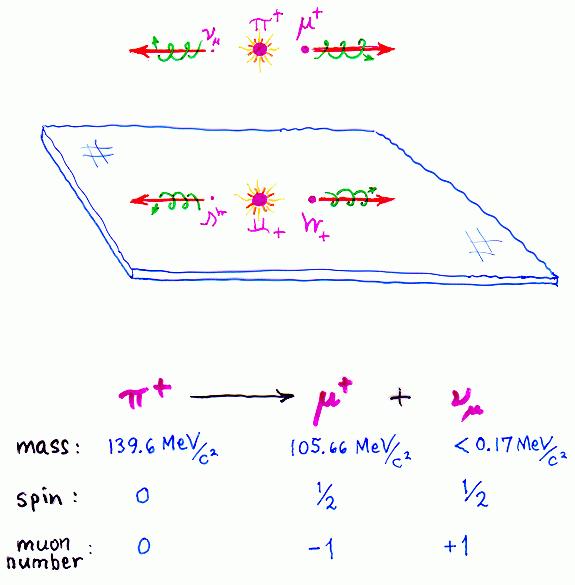Cartoon of Pion Decay and its Mirror Image
The positive pion, a spinless particle, initially has
zero angular momentum and zero linear momentum
(we consider only pion decay at rest).
Therefore linear momentum conservation requires that
the decay products (a positive muon and a muon neutrino)
are emitted in opposite directions with equal and opposite
momenta; meanwhile, angular momentum conservation requires
that they have equal and opposite spin.
The weak interaction governing this decay process
has the remarkable property that it creates
only ``left-handed'' or ``negative helicity'' neutrinos
(i.e. having their spin and angular momentum
in opposite directions, as shown) and ``right-handed''
or ``positive helicity'' antineutrinos,
so the µ+ must also have its spin
pointing back along its momentum. This gives
a beam of perfectly spin-polarized muons from pion decay -
an essential ingredient for µSR.

The mirror-image reaction never occurs in nature,
because the parity inversion performed by the mirror
changes a left-handed neutrino to a right-handed one,
which the weak interaction cannot produce.
If, however, the P (parity) operator is
combined with a C (charge conjugation - changing
all particles to their corresponding antiparticles) operator,
the positive charges change to negative ones and the
neutrino changes to an antineutrino, which is
allowed (in fact required) to have positive
helicity (be right-handed) and the reaction thus altered
is allowed as much as the original one.
These features are now well known, but in 1957 when
they were confirmed it was a veritable cataclysm in
theoretical physics, which had always considered
``parity symmetry'' to be a universal law of nature!
Jess H. Brewer
Last modified: Fri Nov 28 16:17:51 EST

